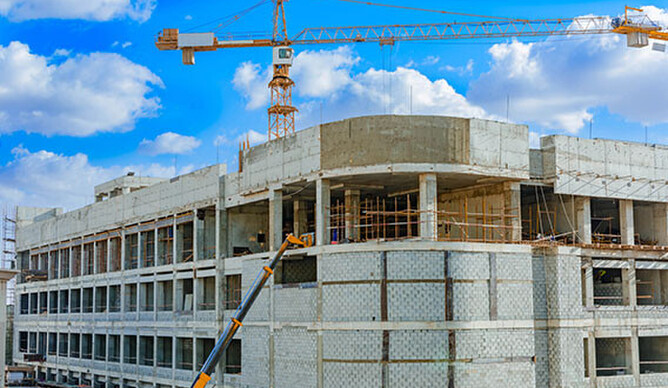The cost of school construction is a key factor to consider for any educational institution planning a new building or renovation. School construction cost per square foot plays a significant role in determining the overall project budget.
The amount spent per square foot depends on various elements such as materials, labor, site location, and design. Understanding the key factors that influence construction costs helps project stakeholders make better decisions and plan more effectively.
Factors That Decide the School Construction Cost per Square Foot
Construction Materials and Their Cost Impact
The choice of materials significantly impacts the cost per square foot in school construction. High-quality materials, such as steel, brick, or specialized insulation, may increase the overall expense.
On the other hand, choosing locally sourced or more economical materials can help reduce costs. It's important to balance durability and aesthetics with the budget. Sustainable materials, such as energy-efficient windows or recycled building materials, are also increasingly popular.
Though these materials may initially cost more, they can lead to long-term savings in energy consumption and maintenance costs. This makes it an attractive option for some school projects.
Carefully selecting materials that fit within the school’s budget can make a considerable difference in the final cost. Not only does the choice of materials affect the overall price, but it also has an impact on construction timelines. For example, materials that are readily available and easy to work with will reduce delays, whereas rare or specialized materials may extend the building process.
Labor Costs in School Construction Projects
Labor is another significant factor influencing the cost per square foot of school construction. Skilled workers such as architects, engineers, and builders are necessary to make sure the project meets safety standards and architectural goals.
Labor costs fluctuate depending on the region, the complexity of the project, and the availability of skilled professionals. In densely populated urban areas like New York, labor costs can be higher due to demand and the availability of qualified workers. Additionally, unionized workers may command higher wages. This can further increase the overall labor cost of the project.
Effective project management and labor coordination are key to controlling costs. Delays in scheduling and labor shortages can extend construction timelines, resulting in additional costs. For this reason, school construction projects must be well-planned. This makes sure that labor is efficiently allocated and work proceeds according to the project schedule.
Site Location’s Effect on Construction Pricing
The location of a school building significantly impacts its construction cost per square foot. If the site requires extensive grading or clearing, costs will rise due to additional work needed before construction begins. A project in an area with difficult terrain or challenging access might face higher costs for transporting materials and workers.
In contrast, a flat, easily accessible site can lower these initial costs. Urban locations may also demand higher prices because of space limitations and the increased complexity of obtaining permits or following city regulations.
Government Regulations Affecting School Building Costs
Government regulations play a significant role in determining school construction costs. Schools must comply with building codes, zoning laws, and other regulations set by local and state authorities.
These regulations may specify requirements for safety features, accessibility, or environmental sustainability, which can increase the cost per square foot. For example, compliance with Americans with Disabilities Act (ADA) standards might require additional accommodations such as ramps, elevators, or specialized bathrooms–all of which add to construction expenses.
In addition, schools must adhere to environmental guidelines, such as energy efficiency standards or green building certifications. This can influence material selection and construction techniques. Local authorities may also impose specific aesthetic or architectural guidelines to maintain a neighborhood’s character. This will further complicate the design process and driving up costs.
While these regulations are necessary to guarantee safety and sustainability, they can significantly affect the budget of a school construction project.
Role of Architecture in Construction Costs
The design and architectural plans for a school building are significant factors in determining the overall cost per square foot. The complexity of the design, the use of specialized structures, and the incorporation of cutting-edge technologies all impact construction pricing.
Simple designs with standard classrooms and common areas tend to be less expensive. Meanwhile, more elaborate buildings with specialized features such as auditoriums, gymnasiums, or science labs may increase costs. Architecturally unique buildings, designed to stand out, also require more investment in design and execution.
Cost Variability Between Elementary and High Schools
The construction cost per square foot varies between elementary schools and high schools due to differences in design, size, and infrastructure requirements. Elementary schools generally require fewer specialized spaces and can be more cost-effective to build.
Classrooms, basic administrative areas, and playgrounds are typical features in an elementary school, all of which contribute to lower square footage costs. On the other hand, high schools need more complex facilities–including specialized classrooms for subjects like chemistry or biology, larger gymnasiums, auditoriums, and sports fields.
As a result, high school construction projects typically have higher costs due to the increased space requirements and specialized features. These additional elements require more materials, labor, and time to complete.
Additionally, the higher number of students attending high schools necessitates larger facilities. This will further drive up the school construction cost per square foot. The complexity and scale of high school buildings must be carefully planned to stay within budget while meeting the needs of students and staff.
Budgeting for School Construction Projects
Material Costs
Selecting cost-effective materials that balance quality and price is key. It is important to avoid overestimating the cost of high-end materials while still guaranteeing that the materials chosen meet safety and durability standards.
Using cost-efficient materials can help reduce per square foot costs. This allows schools to allocate funds to other critical project elements.
Labor Expenses
Skilled labor is necessary. However, cost-effective scheduling helps control expenses. The longer a construction project takes, the higher the labor costs become.
Efficient scheduling and management of labor forces can reduce overtime and prevent unnecessary delays. Project managers must also consider hiring skilled workers who can perform the work efficiently without compromising on quality.
Site Prep Costs
Factors like location and terrain impact preliminary work and the budget. Site preparation is often one of the most unpredictable costs in construction.
For example, land that requires clearing, leveling, or additional soil stabilization can significantly increase costs. It is important to assess the site thoroughly before beginning work to identify any potential issues that could inflate the budget.
Regulatory Costs
Complying with local codes may lead to additional costs for compliance. Building codes and regulations vary by region and can influence construction costs significantly.
Schools must plan for expenses related to acquiring permits, inspections, and adhering to environmental or safety standards. Knowing the specific regulations that apply to the project can help prevent surprises during construction.
Contingency Funds
Having a reserve for unexpected costs guarantees financial stability during construction. Construction projects often face unforeseen circumstances that can lead to budget overruns.
A contingency fund should be built into the initial budget to cover these unexpected costs. This reserve should be substantial enough to handle potential issues without causing financial strain.
Start Your School Construction Project with Reliable Experts at PE Builders
Ready to take the next step with reliable construction contractors for schools? PE Builders specializes in delivering high-quality, sustainable school construction projects across New York. Our team works closely with clients to make sure that every detail meets educational needs while staying within budget.
Trust us to bring your vision to life with professional construction contractors in New York. We deliver results on time and within your financial framework. Let us help make your school construction project a success. Contact PE Builders today!

